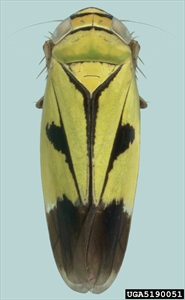-
Restricted. Asia, Africa (Cameroon), Oceania. In Australia, Fiji, Guam, Federated States of Micronesia, Palau, Papua New Guinea.
- A minor pest of lowland irrigated rice. Also on wild grasses and sedges. Sucks sap causing white patches on tillers, wilting and collapse (‘hopperburn’); indirect damage from spreading rice tungro viruses. Note, these viruses NOT in Pacific island countries; nearest country is Irian Jaya.
- Eggs laid into leaf blade or leaf sheath (groups up to 15); nymphs yellow turning light brown, then black; adults, green with two spots extending to tips of forewings, black tips to wings, and head with black bands. Not strong flyers. No large migrations.
- Natural enemies: usually under control by parasites and predators, e.g., Cyrtorhinus lividipennis (see Fact Sheet no. 419).
- Cultural control: isolate nurseries distant from fields preventing tungro virus infections; synchronise planting with neighbours, preventing overlap; create rice-free period so hoppers lose virus infections; transplant >3 week-old seedlings, delaying exposure to infection; do not apply excessive N; weed; check ratoon crops for tungro, and plough in stubble if tungro present; rotate with maize, soybean, peanut, or fallow.
- Chemical control: probably not required. If needed, use neem.






